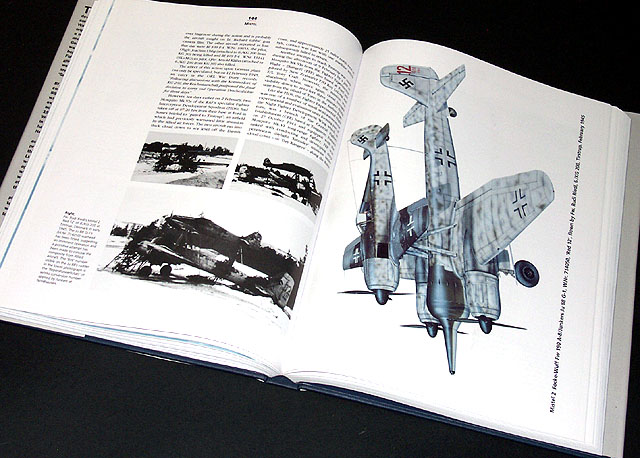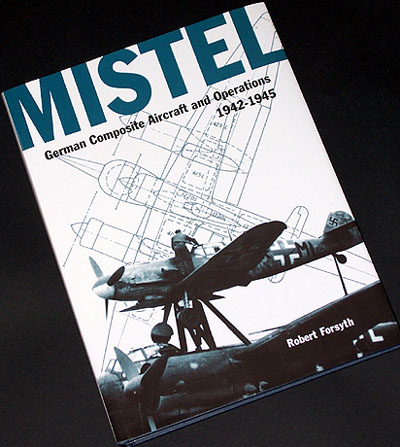|
Mistel
By
Robert Forsyth

Classic
Publications
S u m m a r y
|
| ISBN: |
1-903223-09-1 |
| Media: |
Hardback with colour dust jacket;
303mm x 226mm in portrait format; 288 pages; approx. 300 photographs; line
drawings; tables |
| Price: |
£39.95 plus shipping,
online from Classic Publications
|
| Review Type: |
First Read |
| Advantages: |
The definitive work to date on
Mistel; magnificent coverage of Mistel
concept, execution and operation; highest quality artwork; excellent,
readable and interesting text; attractive layout. |
| Disadvantages: |
|
| Recommendation: |
Highly Recommended |
Reviewed by
Brett Green

HyperScale is proudly supported by
Squadron.com
Classic Publications has established an enviable reputation as the creator of
authoritative reference books on Luftwaffe subjects. During my visit to the IPMS
USA
Nationals in July, I was delighted to see a new hardcover book from Classic
Publications. My already overloaded credit card was handed over as soon as I
leafed through this latest offering.
 "Mistel" by Robert Forsyth is presented in
a hard cover
behind the familiar Classic Publications grey dust jacket. The book is
hefty - 288 pages of high-quality paper containing almost 300 photos in
addition to line drawings, profiles and tables. "Mistel" by Robert Forsyth is presented in
a hard cover
behind the familiar Classic Publications grey dust jacket. The book is
hefty - 288 pages of high-quality paper containing almost 300 photos in
addition to line drawings, profiles and tables.
"Mistel" describes the concept, design and operation of
these composite aircraft.
I was surprised to learn of the experiments by Great Britain during
the First World War including a BE.2c fighter suspended from an airship,
and later practical commercial uses using piggy-back
combinations. British designs of the 1930s permitted non-stop
trans-Atlantic
delivery of mail. Britain also pursued the concept for military
purposes. It was proposed that long-distance bombers might carry a
"parasite fighter" in order to take the fight to the dreaded Fw 200 Condor
in the remote regions of the North Atlantic; or for defence when a bomber was long out of
range of conventional fighter protection. However, these efforts were
ultimately aborted.
In keeping with the title, the bulk of the book concerns itself with
German composite aircraft history and operations. Hugo Junkers adoption
of the concept is discussed; followed by the various combinations
and uses including as a delivery mechanism for assault gliders; to the
final composite bombers. The ultimate German "Mistel" application was for a Luftwaffe fighter
to guide and deliver a bomber with a heavy explosive warhead to
fortified strategic targets. As the lower half of the "Mistel"
combination, the unmanned bomber became a massive bomb. Many obscure
prototypes and projects are described in addition to the more familiar
combinations.
The layout of the book is punctuated with photos, illustrations,
colour profiles and tables, ensuring that the reading is never
laborious. The author's text is comprehensive and informative, while
remaining eminently readable.
"Mistel" is extensively illustrated with colour artwork by Tom Tullis and
Dennis Davison, and technical drawings by Arthur Bentley and Eddie Creek. The colour profiles are a major highlight of this book.
I was especially pleased to see several perspective-view colour
illustrations in addition to the more traditional side-profiles.
Robert Forsyth's book will undoubtedly be recognised as the
definitive reference for
"Mistel" history and operations. The coverage in text and
pictures is simply stunning.
"Mistel" is a
magnificent volume that will appeal to Luftwaffe modellers and history
buffs alike.
Highly Recommended.
Robert Forsyth's "Mistel",
and other Classic books, may be purchased through
specialist bookstores worldwide or from
Classic Publications Website
Review Copyright © 2001 by Brett
Green
This Page Created on 19 November, 2001
Last updated 22 July, 2003
Back to HyperScale
Main Page
Back to Reviews
Page
|
Home | What's
New | Features
| Gallery |
Reviews | Reference
| Forum
| Search